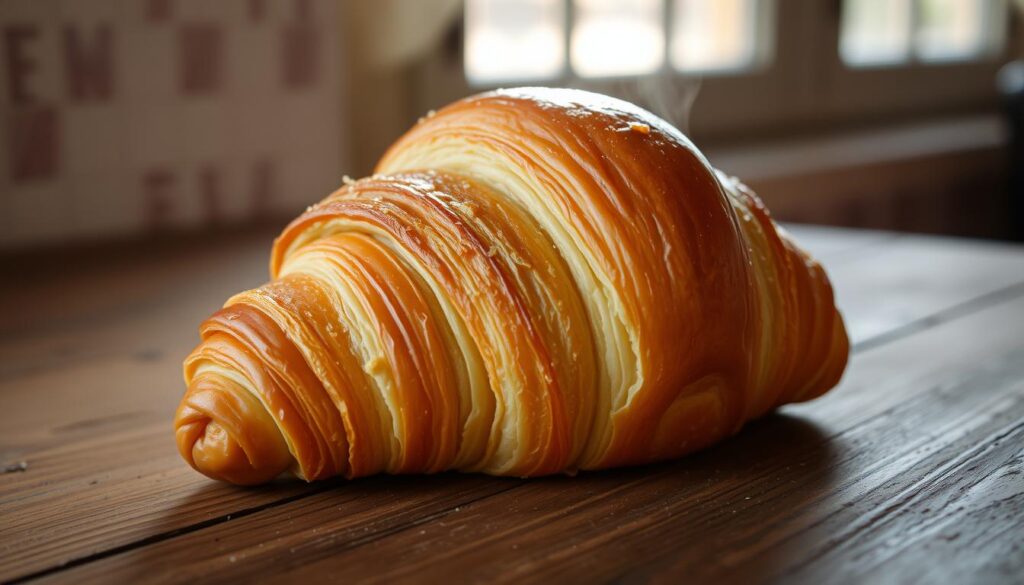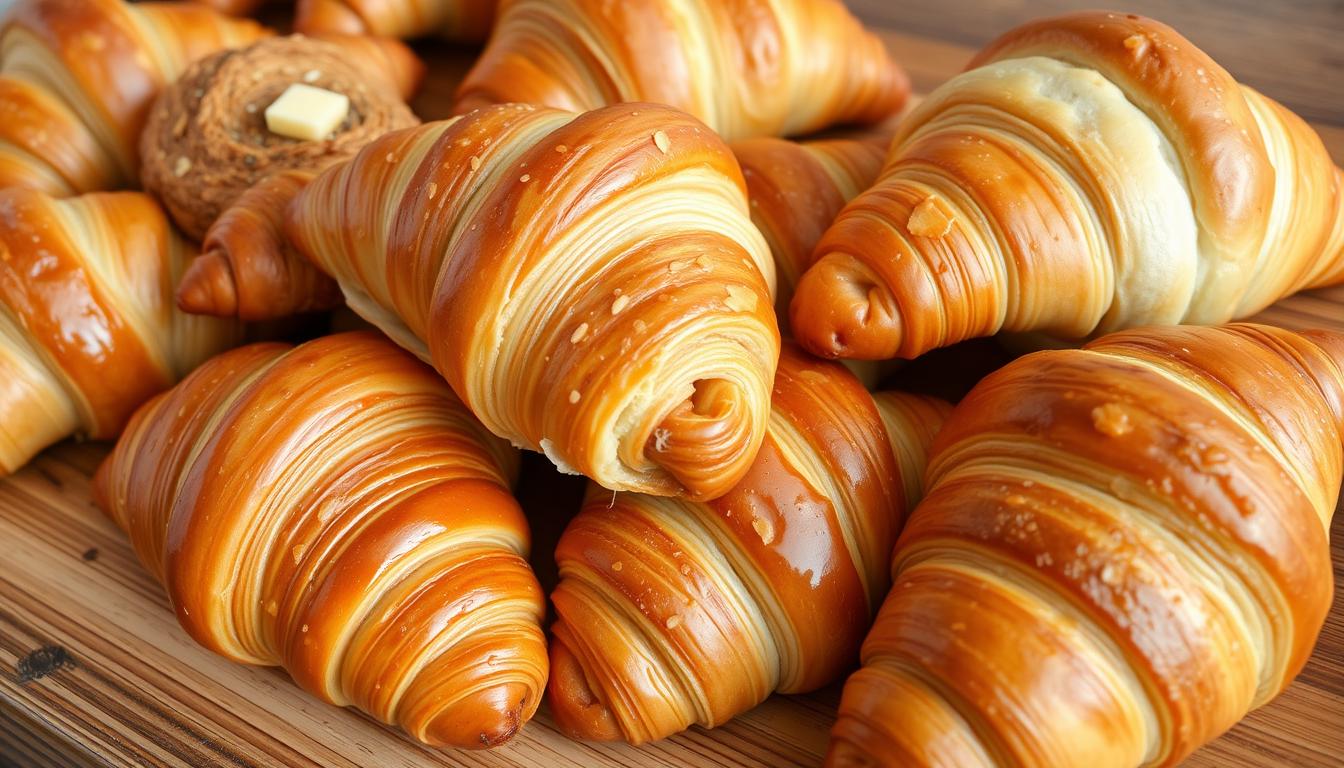Crescent rolls and croissants may look similar, but they are not the same. Croissants and crescent rolls have different histories, ingredients, and ways of making them. They also have different textures and the best times to eat them. Knowing these differences helps us understand if we can use them interchangeably or if they are unique treats.
Key Takeaways
- Crescent rolls and croissants have distinct origins, with croissants being a French delicacy and crescent rolls being an American creation.
- The dough composition and preparation methods vary significantly between the two pastries.
- Croissants undergo a laminating process for flaky layers, while crescent rolls are straightforward doughy rolls.
- Croissants are typically served at breakfast, while crescent rolls are often enjoyed during dinner or holidays.
- The unique characteristics of each pastry make them difficult to substitute for one another in recipes or dishes.
What Are Crescent Rolls?
Crescent rolls are a favorite in America, loved for their flaky, buttery taste and crescent shape. They have a rich history and a special way of being made. This makes them different from croissants.
Origin and Ingredients
Crescent rolls come from the United States, where they’ve been loved for many years. The dough is made with simple ingredients like flour, butter, yeast, and a few more. This recipe lets the natural tastes of the ingredients stand out.
Preparation and Baking Process
To make crescent rolls, the dough is rolled out and cut into triangles. These are then rolled into crescent shapes. The dough is placed on a baking sheet and baked until golden, making them crispy outside and soft inside.
The baking is key to making perfect crescent rolls. The butter melts, creating flaky layers. The yeast makes the rolls light and airy. This results in a delicious pastry that’s great on its own or with other dishes.

“Crescent rolls are a true American classic, bringing joy and comfort to countless homes with their buttery goodness.”
What Are Croissants?
Croissants are a famous French pastry known for their flaky, buttery texture and crescent shape. They are made from a yeast dough that gets layers of butter added to it. This process, called lamination, creates the flaky layers.
The croissant’s history starts in 18th-century Vienna, Austria. It was made to celebrate the Ottoman Empire’s defeat. But it became a favorite in France, especially in Paris, where it’s a symbol of French cooking.
To make a traditional croissant, you need flour, butter, eggs, sugar, and yeast. The dough is kneaded, rolled, and folded with butter layers. Then, it’s shaped into crescents and baked until golden.
The result is a pastry that looks great and tastes amazing. Its golden outside gives way to a soft, airy inside. This inside is filled with a rich, buttery flavor that people love all over the world.

“A well-made croissant is a beautiful thing, a masterpiece of French pastry craft.”
| Key Ingredients | Preparation Steps |
|---|---|
|
|
Key Differences Between Crescent Rolls and Croissants
They look similar, but they are not the same. They have different doughs and ways of making them. Knowing these differences helps us see what makes each pastry special.
Dough Composition
Crescent rolls have a simple dough. It’s made with flour, milk, butter, and a bit of sugar. The dough is kneaded and shaped into crescents before baking.
Croissants have a more complex dough. It’s made with flour, butter, eggs, and yeast. The dough is layered with butter to make it flaky and buttery.
Shaping and Layering Techniques
People shape crescent rolls by rolling the dough into a triangle and then rolling it up from the wide end to the narrow end.
Croissants need a more detailed shaping. The dough is rolled out and folded with butter many times. This creates thin layers of dough and butter, making croissants flaky.
| Characteristic | Crescent Rolls | Croissants |
|---|---|---|
| Dough Composition | Yeast-based, simple | Laminated, complex |
| Shaping Technique | Rolled into a triangle and then rolled up | Repeatedly folded and layered with butter |
| Texture | Soft and tender | Flaky and buttery |
The dough and shaping differences make crescent rolls and croissants unique. Knowing these differences helps us enjoy each pastry for its own special qualities.
Are Crescent Rolls and Croissants the Same?
Crescent rolls and croissants look similar, but they’re not the same. They have different doughs, ways of making them, and tastes. This makes them special treats enjoyed by people all over the world.
Crescent rolls are a favorite in America.People know them for being flaky and buttery on the outside, while soft on the inside. They’re made from a simple dough of flour, butter, yeast, and a few other ingredients.
Croissants, on the other hand, are a French delight. They have a richer taste and a flaky, airy texture. Making croissants involves a special process called lamination, where butter is folded into the dough. This makes them different from crescent rolls.
- Crescent rolls are made with a yeasted dough, while croissants have a laminated dough.
- The preparation techniques differ, with crescent rolls being rolled and shaped, while croissants undergo a complex lamination process.
- Crescent rolls tend to have a simpler, more buttery flavor, while croissants offer a richer, more nuanced taste.
In conclusion, crescent rolls and croissants may look alike, but they’re not the same. They have their own special doughs, making methods, and tastes. Knowing these differences helps us enjoy and appreciate each pastry in its own way.
The Buttery Debate: Crescent Rolls vs. Croissants
Crescent rolls and croissants differ mainly in their butter content. This affects their taste and texture. Croissants have more butter, making them richer and flakier. On the other hand, crescent rolls are lighter, more like biscuits.
Flavor and Texture Comparisons
Croissants have a lot of butter, giving them a deep, buttery taste. When you eat them, the butter melts. Crescent rolls, with less butter, taste more like dough. They are softer and less crisp than croissants.
| Crescent Rolls | Croissants |
|---|---|
| Lighter, more biscuit-like texture | Richer, flakier texture |
| Subtle, dough-like flavor | Indulgent, buttery flavor |
| Lower butter content | Higher butter content |
The unique flavors and textures of crescent rolls and croissants make them perfect for different uses. They cater to different tastes and needs.
“The buttery goodness of a croissant is hard to beat, but the versatility of crescent rolls can’t be ignored.”
Versatility in Cooking and Baking
Crescent rolls and croissants are more than just breakfast foods. They can turn into many savory and sweet dishes. This shows how versatile they are in the kitchen.
Savory Applications
Crescent rolls are great for making appetizers and snacks. Their flaky texture and mild taste are perfect for fillings. You can use them with cheeses, meats, veggies, and herbs.
Croissants are also versatile. You can fill them with ham, cheese, or roasted veggies. They make a tasty and easy-to-eat lunch or snack.
Sweet Versatility
Crescent rolls can make amazing desserts. You can wrap them around chocolate, fruit, or cinnamon. Then, bake them until they’re golden.
Croissants are perfect for sweet pastries. They can be filled with almond or chocolate. This makes them a delicious treat.
But it’s not just about fillings. Crescent rolls and croissants can also be part of baked goods. They add a special texture and flavor to breakfast casseroles, coffee cakes, and savory bread puddings.
“Crescent rolls and croissants are the ultimate chameleons in the kitchen, seamlessly transitioning from savory to sweet and back again.”
Looking to impress with an appetizer, a cozy breakfast, or a sweet dessert? Crescent rolls and croissants are your go-to. They let you show off your cooking skills.
Cultural Significance and Traditions
While crescent rolls and croissants share some similarities, they have unique cultural meanings. They are deeply rooted in their respective regions.
Crescent rolls are a big part of American baking. They are loved at family gatherings, holidays, and as comfort food. In many American homes, they are a key part of meals, from Thanksgiving to weekend brunch. Their familiar shape and buttery taste are key to American baking.
Croissants, on the other hand, are a symbol of French culture. They have a long history, starting in Vienna, Austria, and perfected in France. Their flaky, buttery texture and crescent shape make them a favorite breakfast and snack worldwide.
| Crescent Rolls | Croissants |
|---|---|
| American baking tradition | French culinary heritage |
| Associated with family gatherings and comfort food | Symbolize French culture and traditions |
| Familiar shape and buttery flavor | Flaky, buttery texture and crescent-like shape |
Both crescent rolls and croissants hold deep cultural significance. They are loved for bringing a sense of tradition and nostalgia. Whether it’s the warm smell of crescent rolls or the flaky taste of a French croissant, they are key to their regions’ culinary traditions.
Health Considerations: Which Is Better?
Choosing between crescent rolls and croissants depends on your diet and taste. Both can fit into a healthy diet, but they differ in nutrition.
Crescent Rolls: A Slightly Healthier Option
Crescent rolls are a bit better for you than croissants. They have less butter and fewer calories. They might also have less fat, which is good for those watching their diet.
Croissants: Richer in Butter and Calories
Croissants are known for their rich taste, thanks to more butter. This means they have more calories. If you want something indulgent or have fewer dietary restrictions, croissants might be your pick.
| Nutrition Comparison | Crescent Rolls | Croissants |
|---|---|---|
| Calories (per serving) | 100-150 calories | 200-300 calories |
| Fat Content | 4-8 grams | 10-15 grams |
| Butter Content | Lower | Higher |
Choosing between crescent rolls and croissants depends on your diet and taste. Both can be part of a balanced diet. Crescent rolls are a bit healthier.
Substituting One for the Other
In some cases, you can swap crescent rolls for croissants or the other way around. But, remember, these baked goods have unique qualities. Swapping them can change how they taste, feel, and look.
When It’s Acceptable and When It’s Not
Crescent rolls are soft and flaky, with a rich buttery flavor. They can work as a croissant substitute in some recipes. For example, in breakfast sandwiches or as a base for toppings.
Croissants, however, have a special dough with flaky layers. They’re not the best choice for crescent roll recipes. This is because croissants don’t rise and expand like crescent rolls do in casseroles or other dishes.
Before making a swap, think about the recipe’s needs and how you want the baked good to turn out. Consider the baking time, oven temperature, and the texture and look you’re aiming for. This way, you’ll get the best results when substituting one for the other.
